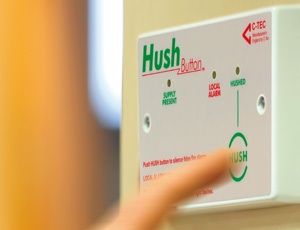 BS5839-6 Hush Buttons BS5839-6 Hush Buttons
Around 80% of all UK fire deaths and injuries occur in
dwellings. Nowhere is the risk greater than in houses of multiple
occupation where a fire in one ‘dwelling’ can quickly spread to another.
Unfortunately, an increased risk of fire means an increased
risk of false alarms. Failure to reduce false alarms can lead to
unnecessary building evacuations, irate tenants, system vandalism and
true alarm signals being ignored.
C-TEC’s Hush Button fire alarm solution tackles all of these
issues head on.
Designed to work with widely available Apollo XP95 or Hochiki
ESP analogue addressable fire alarm systems, it meets and exceeds the
requirements of BS 5839 part 6 (the code of practice for fire alarm
systems in dwellings) by providing reliable, fully monitored fire
detection, alarm and silencing facilities INSIDE each individual flat
or apartment.
How
does the system work?
Each Hush Button can be looked upon as a miniature fully
monitored, self-powered single zone fire alarm panel that sits and is
addressed on an analogue loop (see diagrams below) with the ability to
communicate its status back to the host fire panel.
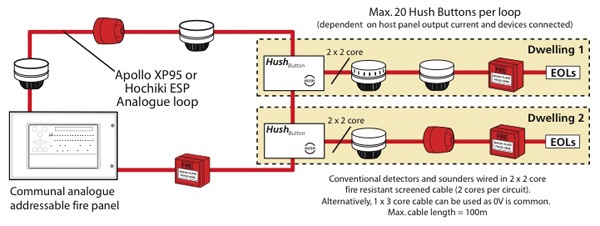
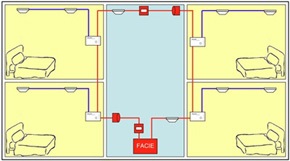 Typically one double gang
Hush Button is fitted in each HMO dwelling complete with conventional
detectors and sounders to provide occupants with a simple,
cost-effective means of invoking two types of ‘hushed’ period, as
specified in clause 12.2 of BS 5839 part 6. Typically one double gang
Hush Button is fitted in each HMO dwelling complete with conventional
detectors and sounders to provide occupants with a simple,
cost-effective means of invoking two types of ‘hushed’ period, as
specified in clause 12.2 of BS 5839 part 6.
The whole system is geared towards reducing unwanted alarms by
putting HMO occupants firmly in control of their own fire detection
systems without losing sight of the fact its primary purpose is to
protect life and property.
Moreover, the fact each Hush Button and its local cabling is
monitored means any open circuit, short circuit or tampering fault is
relayed to building management via the analogue loop and host fire
panel for appropriate remedial action – a feature that is simply not
available on existing Mains/battery type alarm systems.
General
operation
When the fire alarm system is in its normal state (with no
alarm conditions anywhere in the building), power is applied to the
Hush Button’s detector circuit, its detector and sounder circuits are
continually monitored for faults, and its power LED is lit. In the
event of a local alarm condition (when a fire detector within the flat
or apartment has triggered), the Hush Button’s local sounder circuit
will activate and any output devices connected to it will sound.
If there is no one in the apartment to intervene
during a local alarm condition (i.e. if the ‘ Hush’ button is NOT
pressed): The local alarm sounders will sound for a
period of two minutes. If the local alarm clears within these two
minutes, the Hush Button will return to its normal state. If the local
alarm is still present after two minutes, the alarm will be signalled
to the host analogue fire panel and a general alarm condition will be
annunciated around the building as programmed.
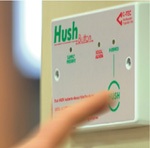 If the ‘Hush’ button is
pressed DURING a local alarm condition: A hushed period
of two minutes will commence starting from when the Hush button is
pressed. If the local alarm is cleared within these two minutes, the
Hush Button will return to its normal state. If the alarm doesn’t
clear, 15 seconds before the hushed period is about to expire, a beeper
will sound to inform the occupant that the alarm is about to be
signalled to the host fire panel. If the ‘Hush’ button is pressed again
during this 15 second period, another two minute hushed period will
commence. If the ‘Hush’ button is
pressed DURING a local alarm condition: A hushed period
of two minutes will commence starting from when the Hush button is
pressed. If the local alarm is cleared within these two minutes, the
Hush Button will return to its normal state. If the alarm doesn’t
clear, 15 seconds before the hushed period is about to expire, a beeper
will sound to inform the occupant that the alarm is about to be
signalled to the host fire panel. If the ‘Hush’ button is pressed again
during this 15 second period, another two minute hushed period will
commence.
If the ‘Hush’ button is pressed when there are
no alarms present: A hushed period of fifteen minutes
will commence. During this period, power is cut to the local zone so no
alarm signals from detectors will be detected (however a manual call
point with a suitable resistor, less than 400 ohms, will trigger a full
alarm if activated). If the ‘Hush’ button is pressed again during this
15 minute period, power is re-applied to the local zone allowing normal
signal processing to resume. 15 seconds before the 15 minute hushed
period is about to expire, a beeper will sound to inform the occupant
that the local zone is about to be re-powered. If the ‘Hush’ button is
pressed again during this 15 second period, another 15 minute hushed
period will commence.
Manual call points
If
a manual call point is connected to the Hush Button’s detector circuit,
provided its resistance when operated is less than 400 ohms, its
operation will immediately trigger the Hush Button’s sounder circuit
and signal a general alarm condition to the host firepanel.
General fire conditions
If,
at any time, the host analogue panel enters a general fire condition,
it overrides any hushed state at the Hush Button and turns on its local
sounders. Pressing the ‘Hush’ button in a general fire alarm condition
WILL NOT silence the local alarm sounders and the dwelling should be
evacuated as per the designated fire management plan.
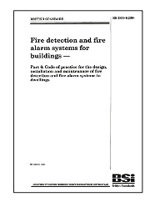 What does the standard say? What does the standard say?
According to BS 5839 part 6 (the code of practice for fire
alarm systems in dwellings) around 80% of all UK fire deaths and
injuries occur in dwellings - that’s a frightening 500 fatalities and
14,000 injuries a year.
In a bid to reduce this figure, the standard specifies minimum
grades and categories for fire alarm systems in dwellings. For HMO
dwellings, it recommends at least Grade D (mains/battery powered
smoke/heat alarms) and Category LD2 or LD3 systems (detectors in all
circulation spaces forming part of its escape routes). It also
acknowledges the need for a BS 5839 part 1 system in all HMO communal
areas.
In recent years, there has been a general trend towards
installing higher-grade EN54 equipment in HMOs so that a single system
covers all of its communal areas and its dwellings in order to give one
route of responsibility for all of the site’s fire alarm requirements.
Unfortunately, many of these systems compromise BS 5839 part 6 in
several key areas. For example, clause 12.2 of BS 5839 part 6 indicates
there be provision within each HMO dwelling for:-
(a)
silencing unwanted alarms when there is a local fire condition; and
(b)
isolating the dwelling’s detectors and sounders when activities are
taking place that could cause a false alarm.
On most current single system solutions, silencing the alarm
sounders can only be done at the communal fire panel which is usually
located outside the dwelling. To initiate this facility, the occupier
must first locate the communal panel, enter its secure user mode and
work out which button to press - all within two minutes. On this point
alone it is clear such systems cannot comply with the clauses nor the
spirit of BS 5839 part 6. The Hush Button solution not only has the
ability to meet the requirements of BS 5839 part 6 in full, it exceeds
them.
• Copies of BS5839-6 can
be purchased from the British Standards Institute at www.bsi-global.com
Summary
/ key features
- Upgrades the level of protection
offered in a flat or apartment from Grade D to Grade A
- Provides
each individual dwelling with a two-minute silence facility and a
15-minute isolate facility to BS 5839 Part 6 clause 12.
- Reduces
the likelihood of unnecessary building evacuations, system vandalism
and the possibility of a true alarm signal being ignored
- Fully
monitored for open and short circuit faults
- Logging
facilities at the main communal panel give full traceability of any
problems
- Can be
operated by building occupants whilst standing at floor level
- Utilises
readily-available cost-effective technology
- Compatible
with the fire alarm industry’s leading analogue protocols - Hochiki’s
ESP and Apollo’s XP95/Discovery
Technical
specifications
|
Max. no of
hush buttons per analogue loop: |
20* (note each Hush Button requires 2 addresses) |
Onboard loop
isolator: |
Yes |
Max. no. of
conv. detectors per hush button: |
10 |
Max. no. of
manual call points per hush button: |
10 |
Max. sounder
circuit load per hush button: |
30mA |
Operating
voltage: |
17-40Vdc |
Quiescent
current: |
5mA |
Max. cable
length of hush button detector circuit: |
100m |
Max. cable
length of hush button sounder circuit: |
100m |
Line
monitored for open and short circuit faults: |
Yes |
User
indicators: |
Supply present; local alarm and hushed LEDs |
|
Buzzer
sounds when hushed period due to expire |
Engineer
Indicators: |
Open/short circuit fault (also shown at host panel) |
Control
buttons: |
Hush |
Dimensions
(WxHxD) in mm: |
144 x 84 x 37. Mounts on a 25mm deep back box |
* dependent on output current of host panel and devices
connected.
Hush
reference sites
Buildings currently benefitiing from C-TEC's Hush Button Fire
Alarm solution include:
 |
|
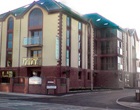 | |
|
Boatman Court
(Student
Accomm'n) Preston
| |
John Robert Gardens
(Housing
Development)
Cumbria |
|
|
Click on the site image for further details.
| 
